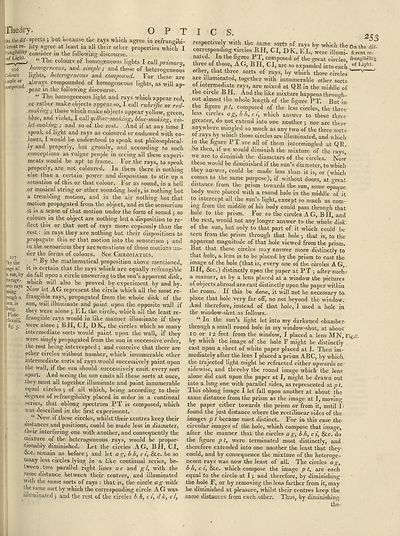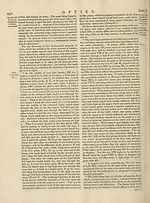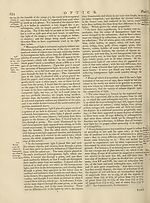Encyclopaedia Britannica > Volume 15, NIC-PAR
(273) Page 253
Download files
Complete book:
Individual page:
Thumbnail gallery: Grid view | List view

Theory. OPT
j)n the dif-spects j but because the rays which agree in refrangibi-
Lferent re- lily agree at least in all their other properties which I
rangibility cons[(|er in the following discourse.
^.Lvlg ‘ “ The colours of homogeneous lights I call primary,
206 homogeneous, and simple $ and those of heterogeneous
Colours lights, heterogeneous and compound. For these are
mpleor a[wayS compounded of homogeneous lights, as will an-
j,™^- ^ in the folio,ving discourse. P
“ The homogeneous light and rays which appear red,
or rather make objects appear so, I call rubrijic or red-
maktng ; those which make objects appear yellow, green,
blue, and violet, I csW yellow-making, blue-making, vio¬
let-making and so oi the rest. And il at any time I
speak of light and rays as coloured or endowed with co¬
lours, I would be understood to speak not philosophical¬
ly and properly, hut grossly, and according to such
conceptions as vulgar people in seeing all these experi¬
ments would be apt to frame. 1'or the rays, to speak
properly, are not coloured. In them there is nothing
else than a certain power and disposition to stir up a
sensation of this or that colour. For as sound, in a hell
or musical string or other sounding body, is nothing but
a trembling motion, and in the air nothing hut that
motion propagated from the object, and in the sensorium
it is a sense of that motion under the form of sound 5 so
colours in the object are nothing hut a disposition to re¬
flect this or that sort of rays more copiously than the
rest: in rays they are nothing but their dispositions to
propagate this or that motion into the sensorium j and
in the sensorium they are sensations of those motions un¬
der the forms of colours. See Chromatics.
By the mathematical proposition above mentioned,
o it is certain that the rays which are equally refrangible
e sun, by t]0 fali Up0n a circle answering to the son’s apparent disk,
.ous°rays WT^C^ VVi'^ a^so he proved by experiment by and by.
| ssincr 7 Now let AG represent the circle which all the most re¬
I c s.
*» * On the
107
rhy the
! :a£e ef
rough a frangible rays, propagated from the whole disk of the
, •im ic QMrt iiTill •llii 1 4-si !A- j.1 11 ‘ n
\ ism, is
long.
Plate
elxxxiii.
% 5-
sun, will illuminate and paint upon the opposite wall if
they were alone; FL the circle, which all the least re¬
frangible rays would in like manner illuminate if they
were alone ; BH, Cl, DK, the circles which so many
intermediate sorts would paint upon the wall, if they
were singly propagated from the sun in successive order,
the rest being intercepted *, and conceive that there are
other circles without number, which innumerable other
intermediate sorts of rays would successively paint upon
the wall, if the sun should successively emit every sort
apart. And seeing the sun emits all these sorts at once,
they must all together illuminate and paint innumerable
equal circles ; of all which, being according to their
degrees of refrangibility placed in order in a continual
scries, that oblong spectrum FT is composed, which
was described in the first experiment.
“ Now if these circles, whilst their centres keep their
distances and positions, could be made less in diameter,
their interfering one with another, and consequently the
mixture of the heterogeneous rays, would be propor-
tionably diminished. Let the circles AG, B H, Cl,
&c. remain as before; and let ag, bh, ci, &c. be so
many less circles lying in a like continual series, be¬
tween two parallel right lines a c and g l, with the
same distance between their centres,. and illuminated
'vith the same sorts of rays : that is, the circle ag with
t he same sort by which the corresponding circle AG was
illuminated; and the rest of the circles b h, ci, dk, el,
corresponding circles BH, CI, DK, EL, were illumi- ferent re-
nated. In the figure F I, composed of the great circles frangibility
three of those, AG, B H, CI, are so expanded into each ,
other, that three sorts of rays, by which those circles ‘
are illuminated, together with innumerable other sorts
of intermediate rays, are mixed at QR in the middle of
the circle B H. And the like mixture happens throuo-h-
out almost the whole length of the figure FT. But&m
the figure pt, composed of the less circles, the three
less circles ag,bh,ci, which answer to those three
greater, do not extend into one another; nor are there
anywhere mingled so much as any two of the three sorts
of rays by which those circles are illuminated, and which
in the figure FT are all of them intermingled at QR.
bo then, if we would diminish the mixture of the rays,
we are to diminish the diameters of the circles. Now
these would he diminished if the sun’s diameter, to which
they answer, could be made less than it is, or (which
comes to the same purpose), if without doors, at great
distance from the prism towards the sun, some opaque
body were placed with a round hole in the middle of it
to intercept all the sun’s light, except so much as com¬
ing from the middle of his body could pass through that
hole to the prism. For so the circles AG, BH, and
the rest, would not any longer answer to the whole disk
of the sun, but only to that part of it which could be
seen from the prism through that hole ; that is, to the
apparent magnitude of that hole viewed from the prism.
But that these circles may answer more distinctly to
that hole, a lens is to be placed by the prism to cast the
image of the hole (that is, every one of the circles AG,
BH, &c.) distinctly upon the paper at PT ; after such;
a manner, as by a lens placed at a window the pictures
of objects abroad are cast distinctly upon the paper within
the room. If this be done, it will not be necessary ta
place that bole very far off, no not beyond the window.
And therefore, instead of that hole, I used a hole in
the window-shut as follows.
In the sun’s light let into my darkened chamber
through a small round hole in my window-shut, at about
10 or 12 feet from the window, I placed a lens MN, Fig.fT.
by which the image of the hole F might be distinctly
cast upon a sheet of white paper placed at I. Then im¬
mediately after the lens I placed a prism ABC, by which
the trajected light might be refracted either upwards or
sidewise, and thereby the round image which the lens
alone did cast upon the paper at I, might be drawn out
into a long one with parallel sides, as represented nipt.
This oblong image I let fall upon another at about the
same distance from the prism as the image at I, moving
the paper either towards the prism or from it, until L
found the just distance where the rectilinear sides of the
images p t became most distinct. For in this case the
circular images of the hole, which compose that image,
after the manner that the circles ag, bh, ci, &c. do
the figure pt, were terminated most distinctly, and
therefore extended into one another the least that they
could, and by consequence the mixture of the heteroge¬
neous rays was now the least of all. The circles ag,
bh, c i, &c. which compose the image p t, are each
equal to the circle at I; and therefore, by diminishing
the hote F, or by removing the lens farther from it, may
be diminished at pleasure, whilst their centres keep the
same distances from each other. Thus, by diminishing
the>
j)n the dif-spects j but because the rays which agree in refrangibi-
Lferent re- lily agree at least in all their other properties which I
rangibility cons[(|er in the following discourse.
^.Lvlg ‘ “ The colours of homogeneous lights I call primary,
206 homogeneous, and simple $ and those of heterogeneous
Colours lights, heterogeneous and compound. For these are
mpleor a[wayS compounded of homogeneous lights, as will an-
j,™^- ^ in the folio,ving discourse. P
“ The homogeneous light and rays which appear red,
or rather make objects appear so, I call rubrijic or red-
maktng ; those which make objects appear yellow, green,
blue, and violet, I csW yellow-making, blue-making, vio¬
let-making and so oi the rest. And il at any time I
speak of light and rays as coloured or endowed with co¬
lours, I would be understood to speak not philosophical¬
ly and properly, hut grossly, and according to such
conceptions as vulgar people in seeing all these experi¬
ments would be apt to frame. 1'or the rays, to speak
properly, are not coloured. In them there is nothing
else than a certain power and disposition to stir up a
sensation of this or that colour. For as sound, in a hell
or musical string or other sounding body, is nothing but
a trembling motion, and in the air nothing hut that
motion propagated from the object, and in the sensorium
it is a sense of that motion under the form of sound 5 so
colours in the object are nothing hut a disposition to re¬
flect this or that sort of rays more copiously than the
rest: in rays they are nothing but their dispositions to
propagate this or that motion into the sensorium j and
in the sensorium they are sensations of those motions un¬
der the forms of colours. See Chromatics.
By the mathematical proposition above mentioned,
o it is certain that the rays which are equally refrangible
e sun, by t]0 fali Up0n a circle answering to the son’s apparent disk,
.ous°rays WT^C^ VVi'^ a^so he proved by experiment by and by.
| ssincr 7 Now let AG represent the circle which all the most re¬
I c s.
*» * On the
107
rhy the
! :a£e ef
rough a frangible rays, propagated from the whole disk of the
, •im ic QMrt iiTill •llii 1 4-si !A- j.1 11 ‘ n
\ ism, is
long.
Plate
elxxxiii.
% 5-
sun, will illuminate and paint upon the opposite wall if
they were alone; FL the circle, which all the least re¬
frangible rays would in like manner illuminate if they
were alone ; BH, Cl, DK, the circles which so many
intermediate sorts would paint upon the wall, if they
were singly propagated from the sun in successive order,
the rest being intercepted *, and conceive that there are
other circles without number, which innumerable other
intermediate sorts of rays would successively paint upon
the wall, if the sun should successively emit every sort
apart. And seeing the sun emits all these sorts at once,
they must all together illuminate and paint innumerable
equal circles ; of all which, being according to their
degrees of refrangibility placed in order in a continual
scries, that oblong spectrum FT is composed, which
was described in the first experiment.
“ Now if these circles, whilst their centres keep their
distances and positions, could be made less in diameter,
their interfering one with another, and consequently the
mixture of the heterogeneous rays, would be propor-
tionably diminished. Let the circles AG, B H, Cl,
&c. remain as before; and let ag, bh, ci, &c. be so
many less circles lying in a like continual series, be¬
tween two parallel right lines a c and g l, with the
same distance between their centres,. and illuminated
'vith the same sorts of rays : that is, the circle ag with
t he same sort by which the corresponding circle AG was
illuminated; and the rest of the circles b h, ci, dk, el,
corresponding circles BH, CI, DK, EL, were illumi- ferent re-
nated. In the figure F I, composed of the great circles frangibility
three of those, AG, B H, CI, are so expanded into each ,
other, that three sorts of rays, by which those circles ‘
are illuminated, together with innumerable other sorts
of intermediate rays, are mixed at QR in the middle of
the circle B H. And the like mixture happens throuo-h-
out almost the whole length of the figure FT. But&m
the figure pt, composed of the less circles, the three
less circles ag,bh,ci, which answer to those three
greater, do not extend into one another; nor are there
anywhere mingled so much as any two of the three sorts
of rays by which those circles are illuminated, and which
in the figure FT are all of them intermingled at QR.
bo then, if we would diminish the mixture of the rays,
we are to diminish the diameters of the circles. Now
these would he diminished if the sun’s diameter, to which
they answer, could be made less than it is, or (which
comes to the same purpose), if without doors, at great
distance from the prism towards the sun, some opaque
body were placed with a round hole in the middle of it
to intercept all the sun’s light, except so much as com¬
ing from the middle of his body could pass through that
hole to the prism. For so the circles AG, BH, and
the rest, would not any longer answer to the whole disk
of the sun, but only to that part of it which could be
seen from the prism through that hole ; that is, to the
apparent magnitude of that hole viewed from the prism.
But that these circles may answer more distinctly to
that hole, a lens is to be placed by the prism to cast the
image of the hole (that is, every one of the circles AG,
BH, &c.) distinctly upon the paper at PT ; after such;
a manner, as by a lens placed at a window the pictures
of objects abroad are cast distinctly upon the paper within
the room. If this be done, it will not be necessary ta
place that bole very far off, no not beyond the window.
And therefore, instead of that hole, I used a hole in
the window-shut as follows.
In the sun’s light let into my darkened chamber
through a small round hole in my window-shut, at about
10 or 12 feet from the window, I placed a lens MN, Fig.fT.
by which the image of the hole F might be distinctly
cast upon a sheet of white paper placed at I. Then im¬
mediately after the lens I placed a prism ABC, by which
the trajected light might be refracted either upwards or
sidewise, and thereby the round image which the lens
alone did cast upon the paper at I, might be drawn out
into a long one with parallel sides, as represented nipt.
This oblong image I let fall upon another at about the
same distance from the prism as the image at I, moving
the paper either towards the prism or from it, until L
found the just distance where the rectilinear sides of the
images p t became most distinct. For in this case the
circular images of the hole, which compose that image,
after the manner that the circles ag, bh, ci, &c. do
the figure pt, were terminated most distinctly, and
therefore extended into one another the least that they
could, and by consequence the mixture of the heteroge¬
neous rays was now the least of all. The circles ag,
bh, c i, &c. which compose the image p t, are each
equal to the circle at I; and therefore, by diminishing
the hote F, or by removing the lens farther from it, may
be diminished at pleasure, whilst their centres keep the
same distances from each other. Thus, by diminishing
the>
Set display mode to:
![]() Universal Viewer |
Universal Viewer | ![]() Mirador |
Large image | Transcription
Mirador |
Large image | Transcription
Images and transcriptions on this page, including medium image downloads, may be used under the Creative Commons Attribution 4.0 International Licence unless otherwise stated. ![]()
| Encyclopaedia Britannica > Encyclopaedia Britannica > Volume 15, NIC-PAR > (273) Page 253 |
|---|
| Permanent URL | https://digital.nls.uk/192585247 |
|---|
| Attribution and copyright: |
|
|---|
| Shelfmark | EB.11 |
|---|---|
| Description | Ten editions of 'Encyclopaedia Britannica', issued from 1768-1903, in 231 volumes. Originally issued in 100 weekly parts (3 volumes) between 1768 and 1771 by publishers: Colin Macfarquhar and Andrew Bell (Edinburgh); editor: William Smellie: engraver: Andrew Bell. Expanded editions in the 19th century featured more volumes and contributions from leading experts in their fields. Managed and published in Edinburgh up to the 9th edition (25 volumes, from 1875-1889); the 10th edition (1902-1903) re-issued the 9th edition, with 11 supplementary volumes. |
|---|---|
| Additional NLS resources: |
|

